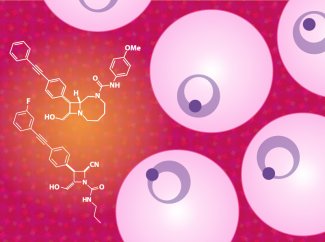
Screens of the Broad’s entire DOS (Diversity Oriented Synthesis) library of over 100,000 small molecules on the malaria parasite P. falciparum have identified compounds that act on a novel malaria target during all three stages of the disease. Image by Susanna Hamilton, Broad Communications
In an effort to look for potential new drug leads to combat malaria, the Broad team, led by Stuart Schreiber, a founding core member of the Broad and director of its Center for the Science of Therapeutics (CSofT), screened CSofT’s full DOS library of small molecular compounds against P. falciparum parasites. This work was funded by a grant from the Bill & Melinda Gates Foundation.
The DOS, or Diversity Oriented Synthesis, library is a unique collection of chemical compounds that are not traditionally represented in pharmaceutical libraries and were designed to emulate small molecules found in nature. Those DOS compounds that showed signs of operating through a novel mechanism of action — a target that current drugs in the pipeline didn’t address and, perhaps, might not be as susceptible to resistance — in the team’s initial screens were prioritized for further study.
Schreiber’s team then prioritized compounds further by applying a second criterium: they looked for compounds that appeared to work in all three stages of the P. falciparum life cycle. Nearly all current antimalarials work during malaria’s «blood stage," during which the parasites circulate in the blood and wreak havoc on the body.
«This compound targets all vertebrate stages of the P. falciparum malaria infection," explains Nobutaka Kato, a senior research scientist in the Broad’s Center for the Development of Therapeutics (CDoT) and
A therapeutic that acts on all three stages could, in theory, be taken at any point prior to or during infection, potentially wiping out parasites before they fester in the liver and are released into the blood. It could also possibly counteract the parasites that are active during the transmission stage. Currently, even individuals undergoing treatment can spread the disease.
When Schreiber’s team looked for compounds that met both criteria — displaying a novel mechanism of action and activity during all three disease stages — a series of compounds stood out. All of them acted on the same target,
The work provides a rich resource for the malaria research community, as the MTRP contains far more therapeutic leads (many with novel mechanisms of action) than the Broad alone can explore. It also shows the utility of this layered, chemical screen approach to drug discovery for infectious disease.
«We have been exploring the use of this novel chemistry almost entirely within the context of the mammalian world, focusing on human disease and cell circuitry, but until recently we hadn’t applied the compounds to pathogen biology. We think these more recent efforts validate this approach for pathogens," says Schreiber, who is also the Morris Loeb Professor in the Department of Chemistry and Chemical Biology at Harvard University and a Howard Hughes Medical Institute investigator.
The findings also suggest that wielding a broader selection of compounds in the search for antimalarials may yield new drug targets. The DOS library contains one hundred thousand unique compounds designed and housed at the Broad — small molecules that are entirely different from those traditionally tested against malaria by other organizations.
«A phrase that is often uttered in our lab is: ‘Will different chemistry yield different outcomes?’ These findings, to us, prove that this is the case," says
All of the chemical structures of the 100,000 DOS library compounds, and the data from the team’s malaria screens, are publicly available via the MTRP. This includes a trove of information on highly active compounds working by previously identified mechanisms of action or by currently unknown mechanisms.
«We invite the scientific community to use this database as a jumping off point for their work developing antimalarial therapies," Schreiber says.


